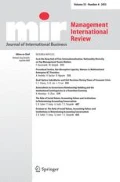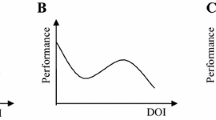Abstract
This paper studies the performance consequences of the speed of SME internationalization. The authors identify three research gaps: few studies treat speed as an independent variable; most studies analyze speed only until internationalization starts; and, finally, studies have paid little attention to the multidimensionality of the speed concept. The authors seek to address these gaps and to contribute to the literature on the dynamics of internationalization by developing three measures of internationalization speed, which capture its multidimensionality. Building on the theories of learning advantage of newness and time compression diseconomies, the study presents three hypotheses on speed’s effect on performance, and the theoretically derived research model is tested on a sample of 183 SMEs visited on site. The analysis demonstrates that the speed of a firm’s increase in the breadth of its international markets has a positive but curvilinear effect on firm performance. It also demonstrates that the speed of a firm’s increase in commitment of foreign resources has a negative but curvilinear effect on the performance of the firm. These results have implications both for scholars interested in the dynamics of firm internationalization and for SME managers.
Similar content being viewed by others
Notes
We reviewed the literature using Web of Science and searched for empirical articles from 1994 to 2014. We used the following keywords to capture internationalization speed: rapid, accelerated, pace, and speed; these were combined with keywords such as foreign market entry, international expansion, and internationalization. As the focus is on SME internationalization, articles on firms other than SMEs were excluded.
For five of the cases we could not access reliable data on the foundation year. When testing the hypotheses we performed analyses both with the ‘replace with mean’ alternative and the ‘delete listwise’ alternative. In the manuscript we report on former results. The reason is that the ‘delete listwise’ alternative returned with significance levels at 5.2 and 5.3 % for the curvilinearity tests.
References
Acedo, F. J., & Jones, M. V. (2007). Speed of internationalization and entrepreneurial cognition: insights and a comparison between international new ventures, exporters and domestic firms. Journal of World Business, 42(3), 236–252.
Autio, E., Sapienza, H. J., & Almeida, J. G. (2000). Effects of age at entry, knowledge intensity, and imitability on international growth. Academy of Management Journal, 43(5), 902–906.
Barkema, H. G., & Vermeulen, F. (1998). International expansion through start up or acquisition: a learning perspective. Academy of Management Journal, 41(1), 7–26.
Bascle, G. (2008). Controlling for endogeneity with instrumental variables in strategic management research. Strategic Organization, 6(3), 285–327.
Bell, J. (1995). The internationalization of small computer software firms: a further challenge to “stage” theories. European Journal of Marketing, 29(8), 60–75.
Bilkey, W. J., & Tesar, G. (1977). The export behavior of smaller Wisconsin manufacturing firms. Journal of International Business Studies, 8(1), 93–98.
Bloodgood, J. M., Sapienza, H. J., & Almeida, J. G. (1996). The internationalization of new high-potential U.S. ventures: antecedents and outcomes. Entrepreneurship Theory and Practice, 20(4), 61–76.
Casillas, J. C., & Acedo, F. J. (2013). Speed in the internationalization process of the firm. International Journal of Management Reviews, 15(1), 15–29.
Casillas, J. C., & Moreno-Menéndez, A. M. (2014). Speed of the internationalization process: the role of diversity and depth in experiential learning. Journal of International Business Studies, 45(1), 85–101.
Cavusgil, S. T. (1980). On the internationalization process of firms. European Research, 8(6), 273–281.
Cavusgil, S. T. (1994). A quiet revolution in Australian exporters. Marketing News, 28(11), 18–21.
Cavusgil, S. T., Zou, S., & Naidu, G. M. (1993). Product and promotion adaptation in export ventures. Journal of International Business Studies, 24(3), 479–506.
Chang, S.-J., & Rhee, J. H. (2011). Rapid FDI expansion and firm performance. Journal of International Business Studies, 42(8), 979–994.
Chetty, S., & Campbell-Hunt, C. (2004). A strategic approach to internationalization: a traditional versus a “born-global” approach. Journal of International Marketing, 12(1), 57–81.
Chetty, S., Johanson, M., & Martin Martin, O. (2014). Speed of internationalization: conceptualization, measurement and validation. Journal of World Business, 49(4), 633–650.
Coeurderoy, R., & Murray, G. (2008). Regulatory environments and the location decision: evidence from the early foreign market entries of new-technology-based firms. Journal of International Business Studies, 39(4), 670–687.
Cohen, W. M., & Levinthal, D. A. (1990). Absorptive capacity: a new perspective on learning and innovation. Administrative Science Quarterly, 35(1), 128–152.
De-Lemos, F., Johanson, J., & Vahlne, J.-E. (2011). Risk management in the internationalization process of the firm: a note on the Uppsala model. Journal of World Business, 46(2), 143–153.
Dierickx, I., & Cool, K. (1989). Asset stock accumulation and sustainability of competitive advantage. Management Science, 35(12), 1504–1511.
Dow, D. (2006). Adaptation and performance in foreign markets: evidence of systematic under-adaptation. Journal of International Business Studies, 37(2), 212–226.
Eriksson, K., Johanson, J., Majkgård, A., & Sharma, D. D. (1997). Experiential knowledge and cost in the internationalization process. Journal of International Business Studies, 28(2), 337–360.
Fernández, Z., & Nieto, M. J. (2006). Impact of ownership on the international involvement of SMEs. Journal of International Business Studies, 37(3), 340–351.
Freeman, S., Edwards, R., & Schroder, B. (2006). How smaller born-global firms use networks and alliances to overcome constraints to rapid internationalization. Journal of International Marketing, 14(3), 33–63.
George, G., Wiklund, J., & Zahra, S. A. (2005). Ownership and the internationalization of small firms. Journal of Management, 31(2), 210–233.
Helfat, C. E., & Peteraf, M. A. (2003). The dynamic resource-based view: capability lifecycles. Strategic Management Journal, 24, 997–1010.
Hilmersson, M. (2014). Small and medium-sized enterprise internationalization strategy performance in times of market turbulence. International Small Business Journal, 32(4), 386–400.
Holzmüller, H. H., & Kasper, H. (1990). The decision-maker and export activity: a cross-national comparison of the foreign market orientation of Austrian managers. Management International Review, 30(3), 217–230.
Jiang, R. J., Beamish, P. W., & Makino, S. (2014). Time compression diseconomies in foreign expansion. Journal of World Business, 49(1), 114–121.
Johanson, J., & Vahlne, J.-E. (1977). The internationalization process of the firm. Journal of International Business Studies, 8(Spring/Summer), 23–32.
Johanson, J., & Wiedersheim-Paul, F. (1975). The internationalization of the firm: four Swedish cases. Journal of Management Studies, 12(3), 305–322.
Jörgensen, E. (2014). Internationalisation patterns of border firms: speed and embeddedness perspectives. International Marketing Review, 31(4), 438–458.
Khavul, S., Pérez-Nordtvedt, L., & Wood, E. (2010). Organizational entrainment and the internationalization of new ventures from emerging markets. Journal of Business Venturing, 25(1), 104–119.
Knight, G. A. (1997). Emerging paradigm for international marketing: The born global firm. Doctoral dissertation, Michigan State University.
Knight, G. A., & Cavusgil, S. T. (1996). The born global firm: A challenge to traditional internationalization theory. In S. T. Cavusgil & T. K. Madsen (Eds.), Advances in international marketing (8) (pp. 11–26). London: JAI Press.
Knott, A. M., Bryce, D. J., & Posen, H. (2003). On the strategic accumulation of intangible assets. Organization Science, 14(2), 192–207.
Lin, W.-T. (2012). Family ownership and internationalization processes: internationalization pace, internationalization scope, and internationalization rhythm. European Management Journal, 30(1), 47–56.
Lu, J. W., & Beamish, P. W. (2006). SME internationalization and performance: growth vs. profitability. Journal of International Entrepreneurship, 4(1), 27–48.
Luo, Y., Zhao, J. H., & Du, J. (2005). The internationalization speed of e-commerce companies: an empirical analysis. International Marketing Review, 22(6), 693–709.
Madsen, T. K., & Servais, P. (1997). The internationalization of born globals: an evolutionary process? International Business Review, 6(6), 561–583.
McDougall, P. P., Oviatt, B. M., & Shrader, R. C. (2003). A comparison of international and domestic new ventures. Journal of International Entrepreneurship, 1(1), 59–82.
Morgan-Thomas, A., & Jones, M. V. (2009). Post-entry dynamics: differences between SMEs in the development speed of their international sales. International Small Business Journal, 27(1), 71–97.
Musteen, M., Francis, J., & Datta, D. K. (2010). The influence of international networks on internationalization speed and performance: a study of Czech SMEs. Journal of World Business, 45(3), 197–205.
Nelson, R. R., & Winter, S. G. (1982). An evolutionary theory of economic change. Cambridge, MA: Harvard University Press.
Nummela, N., Saarenketo, S., & Puumalainen, K. (2004). A global mindset—a prerequisite for successful internationalization. Canadian Journal of Administrative Sciences., 21(1), 51–64.
Oviatt, B. M., & McDougall, P. P. (1994). Toward a theory of international new ventures. Journal of International Business Studies, 25(1), 45–64.
Oviatt, B. M., & McDougall, P. P. (2005). Defining international entrepreneurship and modeling the speed of internationalization. Entrepreneurship Theory and Practice, 29, 537–553.
Penrose, E. (1959). The theory of the growth of the firm. New York: John Wiley and Sons.
Pla-Barber, J., & Escribá-Esteve, A. (2006). Accelerated internationalisation: evidence from a late investor country. International Marketing Review, 23(3), 255–278.
Podsakoff, P. M., MacKenzie, S. B., Lee, J. Y., & Podsakoff, N. P. (2003). Common method biases in behavioral research: a critical review of the literature and recommended remedies. Journal of Applied Psychology, 88(5), 879–903.
Prashantham, S., & Young, S. (2011). Post-entry speed of international new ventures. Entrepreneurship Theory and Practice, 35(2), 275–292.
Ramos E., Acedo F., & Gonzalez R. (2011). Internationalization speed and technological patterns: a panel data study on Spanish SMEs. Technovation, 31(10–11), 560–572.
Rugman, A. M., & Verbeke, A. (2004). A perspective on regional and global strategies of multinational enterprises. Journal of International Business Studies, 35, 3–18.
Sapienza, H. J., Autio, E., George, G., & Zahra, S. A. (2006). A capabilities perspective on the effects of early internationalization on firm survival and growth. Academy of Management Review, 31(4), 914–933.
SOU (2008). Svensk export och internationalisering: Utveckling, utmaningar, företagsklimat och främjande. SOU:90.
Trudgen, R., & Freeman, S. (2014). Measuring the performance of born-global firms throughout their development process: the roles of initial market selection and internationalization speed. Management International Review, 54(4), 551–579.
Vermeulen, F., & Barkema, H. (2002). Pace, rhythm, and scope: process dependence in building a profitable multinational corporation. Strategic Management Journal, 23(7), 637–653.
Wagner, H. (2004). Internationalization speed and cost efficiency: evidence from Germany. International Business Review, 13(4), 447–463.
Wernerfelt, B. (1984). A resource-based view of the firm. Strategic Management Journal, 5(2), 171–180.
Zhou, L. (2007). The effects of entrepreneurial proclivity and foreign market knowledge on early internationalization. Journal of World Business, 42(3), 281–293.
Zhou, L., & Wu, A. (2014). Earliness of internationalization and performance outcomes: exploring the moderating effects of venture age and international commitment. Journal of World Business, 49, 132–142.
Zucchella, A., Palamara, G., & Denicolai, S. (2007). The drivers of the early internationalization of the firm. Journal of World Business, 42(3), 268–280.
Acknowledgments
The authors would like to express their gratitude to Jan Wallanders and Tom Hedelius research funds for their financial support for the data collection. The authors also would like to thank Susanne Sandberg for her support in the data collection process. The anonymous reviewers in Management International Review have significantly improved the paper thanks to their insightful and constructive comments.
Author information
Authors and Affiliations
Corresponding author
Rights and permissions
About this article
Cite this article
Hilmersson, M., Johanson, M. Speed of SME Internationalization and Performance. Manag Int Rev 56, 67–94 (2016). https://doi.org/10.1007/s11575-015-0257-4
Received:
Revised:
Accepted:
Published:
Issue Date:
DOI: https://doi.org/10.1007/s11575-015-0257-4




